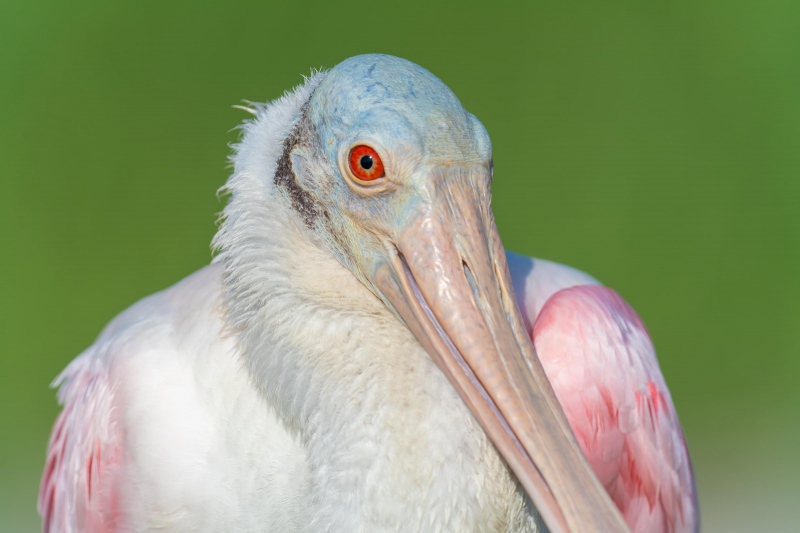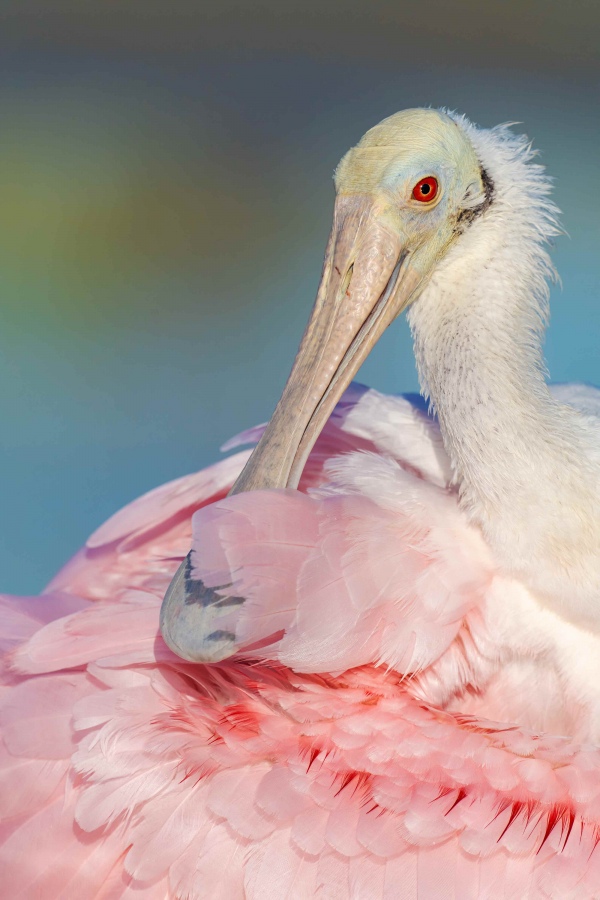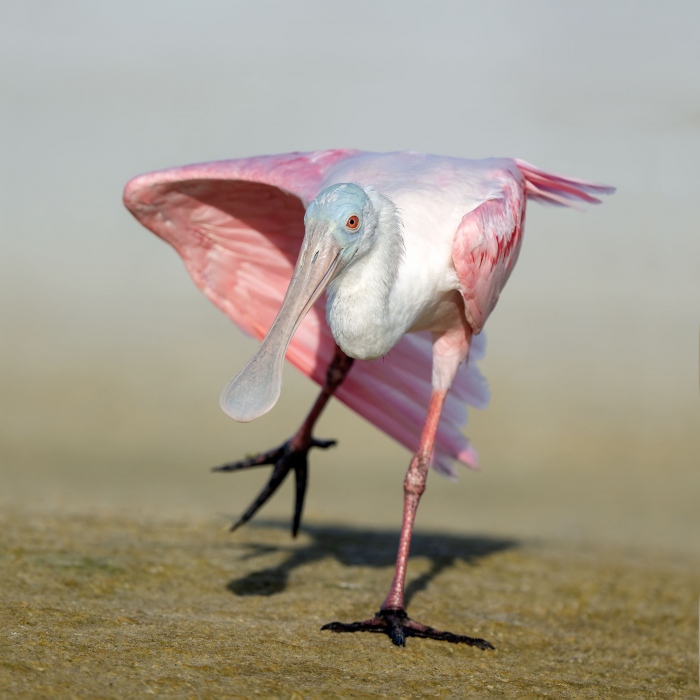|
|
Creating the World’s Best JPEGs (Video) |
Creating the World’s Best JPEGs Video: $23.00
Be sure to click on each of today’s spoonbill images to see the amazing quality of the JPEGs. Then consider purchasing the video and learning to make stunning JPEGs of your best images.
In this 16-minute video, you will learn to create relatively small, high-quality JPEGs to varying size specifications. However you wish to size your JPEGs, you will learn to create and sharpen highly detailed JPEGs that can be saved while limiting the file size. The method that I use to generically sharpen all my JPEGs is unique. Sharpening the whole image saves a ton of time and with the values that I use, nobody has ever commented on over-sharpening and the final results are spectacular. In the video, I show you exactly how I create and sharpen JPEGs for the blog and how I create and sharpen JPEGs for BirdPhotographer’s.Net. With my recipe, you will learn to create JPEGs to your specific size requirements while at the same time, maximizing image quality and limiting the file size.
Thanks to Anke Frohlich for pointing me in the right direction as to creating fabulous JPEGs.
You can order your copy here in the BAA Online Store.
What’s Up
With photography down by the lake at ILE down the tubes, and the three large grassy fields much too wet to drive on, I’ve decided to cancel my morning outings until I head to Long Island on 31 July. I head back south on 31 August and should be back home on 1 September barring anything unforeseen. I will be offering In-the-Field sessions at both Nickerson Beach and the East Pond at Jamaica Bay Wildlife Refuge. If you are interested, please get in touch via e-mail or text me at 863-221-2372.
Whether you are a local or like to fly in for several days of instruction — a sort of private– or small group, at worst, IPT, LMK via e-mail and we can work on a schedule that could possibly include both Nickerson and Jamaica Bay.
With nine deposit checks in hand, and with good friend Ed Dow grabbing a single cabin, there are only three openings left on the 2023 Galapagos Photo-cruise of a Lifetime. The trip is now a go. If you have any interest in joining us, it would be best to get in touch via e-mail ASAP.
Speaking of IPTs, I am still looking for someone to do all three Homer Bald Eagle trips and driving the round trip from Anchorage to Homer and back with me. Toward that end, I am offering a ridiculously high discount of $4500.00, $1500 off each trip. The offer may not last long because there are only two slots left on the second IPT. If you are interested, or would like additional details, please contact me via e-mail
Today is 21 July 2022. Wherever you are and whatever you are doing, I hope that you too have a great day. This blog post took about two 1/2-hours to prepare (including the time spent on the three image optimizations) and makes one hundred twenty-three days in a row with a new one.
Please remember to use the B&H and Amazon links that are found on most blog pages and to use the BIRDSASART discount code at checkout when purchasing your new gear from Bedfords to get 3% back on your credit card and enjoy free second-day air FedEx. Please, also, consider joining a BAA IPT. You will be amazed at how much you will learn!
The First DeSoto IPT
If you are interested in the first DeSoto IPT, 3 1/2 Days, Tuesday 27 September through the morning session on Friday 30 September 2022, know that I have reserved a three-bedroom AirBnB in Gulfport. Share it for four nights with many multiple IPT veteran Monte Brown and me and save a ton on lodging: $83.69/night/person for a whole home. AirBnB photos available upon request. Scroll down for details. If interested, shoot me an e-mail.
Follow me on Instagram here. I am trying to feature both new and old images, especially images that have not appeared recently on the blog. Or search for birds_as_art.
BIRDS AS ART Image Optimization Service (BAA IOS)
Send a PayPal for $62.00 to birdsasart@verizon.net or call Jim at 863-692-0906 and put $62.00 on your credit card. Pick one of your best images and upload the raw file using a large file sending service like Hightail or DropBox and then send me the link via e-mail. I will download and save your raw file, evaluate the exposure and sharpness, and optimize the image as if it were my own after converting the raw file in Adobe Camera Raw. Best of all, I will make a screen recording of the entire process and send you a link to the video to download, save and study.
Induro GIT 304L Price Drop
Amazingly, we have two, brand-new-in-the-box Induro GIT 304L tripods in stock. They are $699.00 each (were $799.00) and the price now includes the insured ground shipping to the lower 48 states. Weekday phone orders only: 863-692-0906.
|
|
|
This image was created on 18 September 2020 on the IPT on a DeSoto IPT. I used the no-longer available (except from BAA) Induro GIT 304L tripod/Levered-Clamp FlexShooter Pro-mounted Sony FE 600mm f/4 GM OSS lens, the Sony FE 2.0x Teleconverter, and the Sony a7R IV (now replaced for me by The One, the Sony Alpha 1 Mirrorless Digital Camera). The exposure was determined via Zebra technology with ISO on the thumb dial. ISO 400. 1/640 sec. at f/9 (stopped down 1/3-stop) in Manual mode. When evaluated in RawDigger, the raw file exposure was determined to be perfect. AWB at 5:27:19pm on a sunny afternoon. Flexible Spot AF-C. Be sure to click on the image to enjoy a high-res version. Image #1: Roseate Spoonbill — tight horizontal face portrait |
Getting Close
Working with a single client, I was told that the spoonbills standing on the limestone road were very skittish and that we would never be able to get anywhere near them. I disagreed, and said, “Follow me.” We took a wide circular route around the birds to avoid scaring them. Then we lowered our tripods and sat down on the grass. The perspective was great as the road was elevated about a foot. We pushed our tripods ahead of us, scooched forward a few feet, and made a few images each time we stopped. That to get the birds used to the faint sound of the shutters. We got to with 25 feet of the birds, made a ton of wonderful images, and backed out the way we came, leave eight spoonbills standing on the road.
Head Angle
Note that when a bird is facing you, the 45-degree head angle is often best.
scooch
Verb — transitive + intransitive: to move a short distance by or as if by sliding
|
|
|
This image was created on 22 September 2020 on the IPT on a DeSoto IPT. I used the no-longer available (except from BAA) Induro GIT 304L tripod/Levered-Clamp FlexShooter Pro-mounted BLUBB-supported Sony FE 600mm f/4 GM OSS lens, the Sony FE 2.0x Teleconverter, and the Sony a7R IV (now replaced for me by The One, the Sony Alpha 1 Mirrorless Digital Camera). The exposure was determined via Zebra technology with ISO on the thumb dial. ISO 1000. 1/1600 sec. at f/9 (stopped down 1/3-stop) in Manual mode. When evaluated in RawDigger, the raw file exposure was determined to be perfect. AWB at 8:26:16am on a barely sunny morning. Flexible Spot AF-C. Be sure to click on the image to enjoy a high-res version. Image #2: Roseate Spoonbill — preening vertical |
A Little-Known Pink Fact
Many folks do not realize that the best time of the year for photographing spoonbills at Fort DeSoto is early fall. Though they are not guaranteed on the Fall IPTs, we almost always wind up with some great chances on one of Florida’s most popular photographic subjects. Join me this coming fall to get a pink fix.
Head and Bill Position
The trick when shooting preening birds is to press the shutter button when you have a clear view of the bird’s face and eye and when the plane of the face and bill are as close as possible to being parallel to the plane of the sensor, i.e., to the plane of the back of the camera body.
|
|
|
This image was created on 20 September 2021 on a Fort DeSoto IPT. Seated on damp sand I used the lowered, no-longer available (except from BAA) Induro GIT 304L tripod/Levered-Clamp FlexShooter Pro-mounted Panning Ground Pod-supported Sony FE 600mm f/4 GM OSS lens with the Sony FE 1.4x Teleconverter, and The One, the Sony Alpha 1 Mirrorless Digital Camera.. ISO 1000. The exposure was determined by Zebras with ISO on the rear wheel: 1/3200 second at f/5.6 (wide open) in Manual mode. RawDigger showed that the exposure was perfect. AWB at 8:37:29am on sunny morning with just a bit of haze in front of the sun. Tracking: Spot S/AF-C with Bird-Eye/Face Detection performed perfectly. Click on the image to enjoy the high-res version. Image #3: Roseate Spoonbill — stretching |
Do You Like the Shadow?
Do you like the shadow of the bird on the sand in Image #3? Why or why not?
How might I have eliminated the shadow?
Your Favorite?
Which of today’s three featured images do you like best? Why?
Unsolicited via e-mail from Pete Myers
I just spent 4 days in the field in a graduate course in bird photography taught by Artie Morris at Fort DeSoto. After almost 50 years of experience pointing cameras at birds from the Arctic to Tierra del Fuego, New Zealand and beyond, I thought I was good enough. But what I learned from Artie in just four days has taken me to a whole new level. As he aptly puts it, “birds as art,” not simply bird photography. One of those 4 days was the most satisfying I’d ever experienced, anywhere. The IPT left me euphoric about what I’d learned, and frighteningly committed to recreating my portfolio with the techniques and insights he taught me.
Via e-mail from Jim Miller
I can’t stop thinking about how much fun the DeSoto Fall IPT was, and how much I learned. There were so many things that suddenly made perfect sense after I had been confused for so long. Thank you very much for the wonderful trip, and for being a great teacher. As I worked through the raw files last week, I realized what a fantastic lens the 600 GM is. Thanks for the rental! Maybe someday I will be able to afford one. Some images for critique are attached.
By the way, the plant we were looking at along the sidewalk in Gulfport is Blue Porterweed. It is worth a few minutes on the internet to read about it: native of Florida and the Caribbean, used for medicine in The Bahamas, etc. We have it in a large pot in the front yard and it takes a lot of water, but it blooms Spring through Fall. Thank you again, Artie. It was really wonderful to be with you and learn from you.
Via e-mail from Lee Sommie
I want to thank you for making the Fall 2017 Ft. DeSoto IPT such a fun and educational experience for me. I truly did not want the adventure to end. I now look through the viewfinder with an artist’s mindset. And the real bonus was making new friends with fellow students. Thank you for sharing your knowledge and enthusiasm for wildlife photography. I had a great time with you and look forward to more adventures on future IPTs.
Followed by this one
BTW. I downloaded Photo Mechanic and started using it in my workflow. Since I like using Lightroom for my adjustments, I found a way to incorporate Photo Mechanic and Lightroom together. Lightroom was driving me crazy with how slow it is to import and preview photos. I was impressed with how fast you could preview photos and start editing your photos on the DeSoto Fall IPT. Life is too short to wait for applications to import and preview photos and Photo Mechanic solves that problem.
Via e-mail from Muhammad Arif
I had a great time at Fort DeSoto. Thank you for all the instruction, for your help and pointers; my photography has already improved tremendously, and I’ve never made such good bird photos before. I wish I could’ve joined you on Monday and Tuesday morning as well, but work got in the way. It was also nice meeting the folks on the IPT. Thanks again for everything and I hope to join you at a future IPT sometime again.
|
Fort DeSoto in fall is rife with tame birds. All the images on this card were created at Fort DeSoto in either late September or very early October. I hope that you can join me there this fall. Click on the composite to enjoy a larger version. Clockwise from upper left to center: Long-billed Curlew, Marbled Godwit, Caspian Tern, Great Egret, Sandwich Tern with fish, Willet, Black-bellied Plover threat display, Snowy Egret, 2-year old Yellow-Crowned Night-Heron, juvenile Yellow-Crowned Night-Heron. |
The Fall 2022 Fort DeSoto Instructional Photo-Tours
Fall 2022 Fort DeSoto Instructional Photo-Tour #1
3 1/2 Days: Tuesday 27 September through the morning session on Friday 30 September 2022. $1899.00 includes three working lunches. Limit six photographers/Openings five.
Fall 2022 Fort DeSoto Instructional Photo-Tour #2
3 1/2 Days: 7 October through the morning session on Monday 10 October 2022. $1899.00 includes three working lunches. Limit six photographers.
Fall 2022 Fort DeSoto Instructional Photo-Tour #3
3 1/2 Days: Monday 31 October through the morning session on Thursday 3 November 2022. $1899.00 includes three working lunches. Limit six photographers.
Fort DeSoto, located just south of St. Petersburg, FL, is a mecca for migrant shorebirds and terns in fall. There they join hundreds of egrets, herons, night-herons, and gulls that winter on the T-shaped peninsula. With any luck at all, we should get to photograph one of Florida’s most desirable shorebird species: Marbled Godwit. Black-bellied Plover and Willet are easy, American Oystercatcher is pretty much guaranteed. Great Egret, Snowy Egret, Great Blue Heron, Tricolored Heron, and White Ibis are easy as well and we will almost surely come up with a tame Yellow-crowned Night-Heron or two. And we will get to do some Brown Pelican flight photography. In addition, Royal, Sandwich, Forster’s, and Caspian Terns will likely provide us with some good flight opportunities as well. Though not guaranteed, Roseate Spoonbill and Wood Stork might well be expected. And we will be on the lookout for a migrant passerine fallout in the event of a thunderstorm or two.
On this IPT, all will learn the basics and fine points of digital exposure. Nikon and Canon folks will learn to get the right exposure every time after making a single test exposure, and SONY folks will learn to use Zebras so that they can be sure of making excellent exposures before pressing the shutter button. Everyone will learn how to approach free and wild birds without disturbing them, to understand and predict bird behavior, to identify many species of shorebirds, to spot the good situations, to choose the best perspective, to see and understand the light, and to design pleasing images by mastering your camera’s AF system. Most importantly, you will surely learn to evaluate wind and sky conditions and understand how they affect bird photography. And you will learn how and why to work in Manual mode (even if you’re scared of it). The best news is that you will be able to take everything you learn home with you so that you will be a better photographer wherever and whenever you photograph.
There will be a Photoshop/image review session during or after lunch (included) each full day. That will be followed by Instructor Nap Time.
These IPTs will run with only a single registrant (though that is not likely to happen). The best airport is Tampa (TPA). Once you register, you will receive an e-mail with Gulfport AirBnB information. If you register soon and would like to share an AirBnB with me, shoot me an e-mail. Other possibilities including taking a cab to and from the airport to our AirBnB and riding with me. This saves you both gas and the cost of a rental car.
A $600 deposit is due when you sign up and is payable by credit card. Balances must be paid by check two months before the trip. Your deposit is non-refundable unless the IPT sells out with six folks, so please check your plans carefully before committing. You can register by calling Jim or Jennifer during weekday business hours at 863-692-0906 with a credit card in hand, or by sending a check as follows: make the check out to: BIRDS AS ART and send it via US mail here: BIRDS AS ART, PO BOX 7245, Indian Lake Estates, FL 33855. You will receive a confirmation e-mail with detailed instructions, clothing, and gear advice. Please shoot me an e-mail if you plan to register or if you have any questions.
|
Clockwise from upper left to center: Long-billed Curlew, juvenile Tricolored Heron, Marbled Godwits, Great Blue Heron, juvenile Pectoral Sandpiper, Wood Stork, smiling Sea Scallop, Ruddy Turnstone scavenging needlefish, Great Blue Heron sunset silhouette at my secret spot, and southbound migrant tern flock blur. |
Up Early, Stay Out Late!
Obviously, folks attending an IPT will be out in the field early and stay late to take advantage of the sweetest light and sunrise and sunset colors (when possible). The good news is that the days are relatively short in early fall. I really love it when I am leaving the beach on a sunny morning after a great session just as a carful or two of well-rested photographers are arriving. The length of cloudy morning sessions will often be extended. Click on the composite to enjoy a larger version.
Typos
With all blog posts, feel free to e-mail or to leave a comment regarding any typos or errors.




















The second photo is absolutely stunning!
#2 is my absolute favorite! Great capture of delicate colors of the spoonbill’s head and fabulous capture of pink feathers (with a litte cerise thrown in). Not to mention the soft background colors.